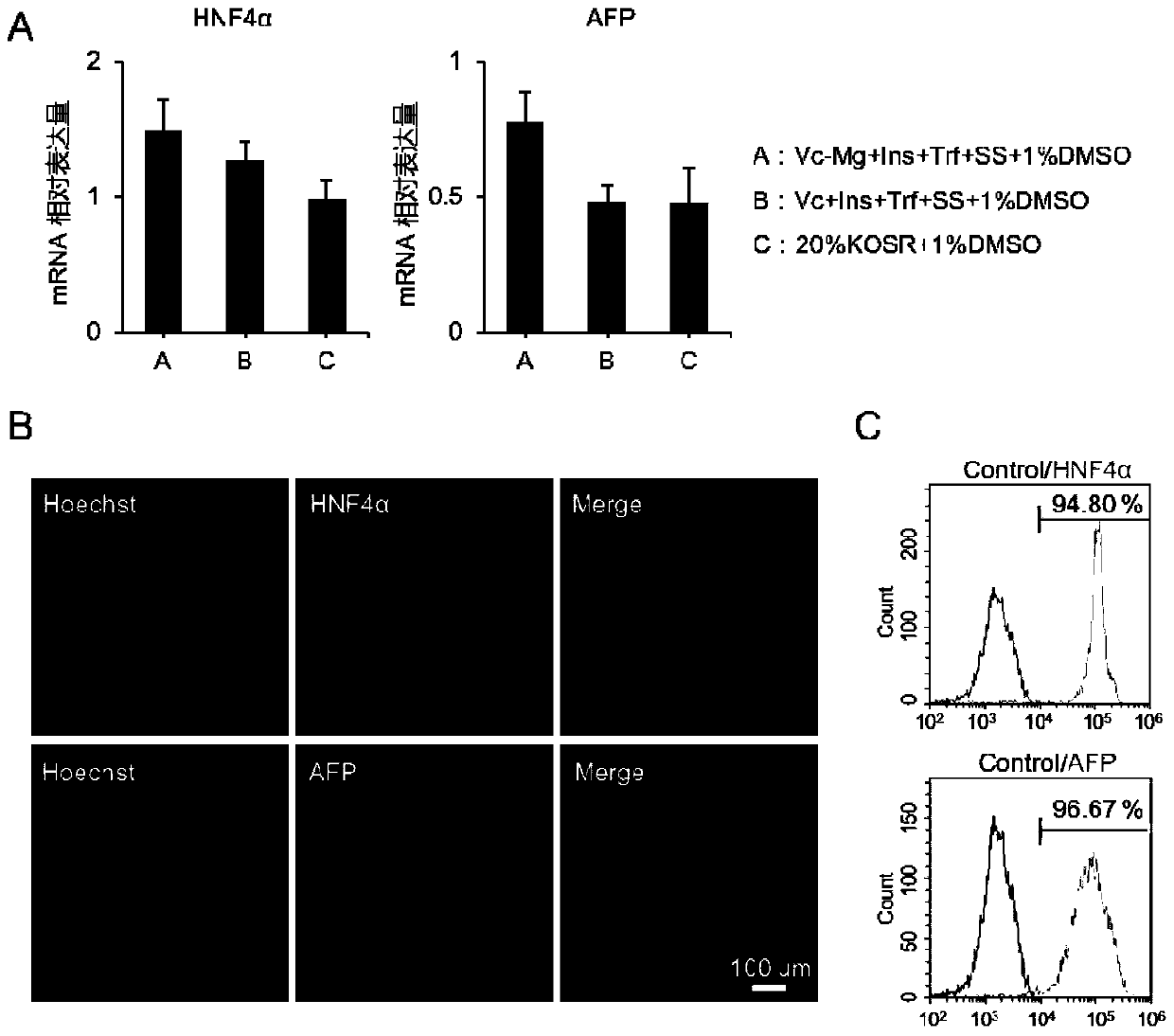Method for inducing stem cells into liver cells and kit
A kit and stem cell technology, which can be used in cell culture active agents, embryonic cells, animal cells, etc., can solve problems such as high cost and complications
- Summary
- Abstract
- Description
- Claims
- Application Information
AI Technical Summary
Problems solved by technology
Method used
Image
Examples
Embodiment 1
[0090] This experiment takes clinical-grade human embryonic stem cells (CTS-hES) as the object (see Qi Gu, et al., Accreditation of Biosafe Clinical-Grade Human Embryonic Stem Cells According to Chinese Regulations (2017). stem cell reports, vol 9,1-15), evaluating the ability of the culture system of the present invention to induce the differentiation of embryonic stem cells into hepatocytes. Wherein, the differentiation degree and differentiation efficiency of CTS-hES during culture were detected by immunofluorescence and flow cytometry.
[0091] 1. Detection method
[0092] (1) Detection of protein expression by immunofluorescence staining
[0093] Specific operation steps: Put slides in a 24-well plate, dilute Matrigel matrix with CTS Knock-out DMEM culture medium (that is, add 50 μL Matrigel to 6 mL CTS Knock-out DMEM culture medium), spread it in a 24-well plate, 200 μL per well, put in CO 2 After standing in the incubator for 30 minutes, the cells were attached to th...
Embodiment 2
[0110] Example 2 Evaluation of the ability of the culture system described in this application to induce differentiation of human induced pluripotent stem cells (hiPSCs) into hepatocytes
[0111]This experiment takes clinical grade hiPSCs as the object (see Juan Wang, et al., Generation of clinical-grade human induced pluripotent stem cells in Xeno-free conditions, Stem Cell Research & Therapy (2015), 6:223 for the cell acquisition method), Referring to the differentiation induction method in Example 1, the ability of the culture system described in this application to induce the differentiation of hiPSCs into hepatocytes was evaluated, and the results are shown in Figure 5 .
Embodiment 3
[0112] Example 3 In vitro functional testing of differentiated hepatocytes
[0113] Through the following experiments, the liver cells differentiated in Example 1 were tested for in vitro function, and the results are shown in Figure 6 .
[0114] 1. Oil red staining experiment
[0115] (1) Preparation of Oil Red O: Weigh 0.5g of oil red dry powder that has been ground and crushed in advance, dissolve it in 10mL of isopropanol, then add isopropanol to 100ml, seal the brown bottle (or wrap it in tin foil to avoid light) at 4°C Preservation, as a storage solution, can be preserved for a long time. When in use, take 6 mL of oil red solution and add 4 mL of three-distilled water, mix well, filter with qualitative filter paper, and use up within 3 hours after dilution.
[0116] (2) Cell fixation: Discard the culture supernatant, add 100 μL PBS to each well and wash once, taking a 24-well plate as an example, add 200 μL 4% PFA to each well and fix at room temperature (25°C) for...
PUM
| Property | Measurement | Unit |
|---|---|---|
| concentration | aaaaa | aaaaa |
| concentration | aaaaa | aaaaa |
| concentration | aaaaa | aaaaa |
Abstract
Description
Claims
Application Information
 Login to View More
Login to View More - R&D
- Intellectual Property
- Life Sciences
- Materials
- Tech Scout
- Unparalleled Data Quality
- Higher Quality Content
- 60% Fewer Hallucinations
Browse by: Latest US Patents, China's latest patents, Technical Efficacy Thesaurus, Application Domain, Technology Topic, Popular Technical Reports.
© 2025 PatSnap. All rights reserved.Legal|Privacy policy|Modern Slavery Act Transparency Statement|Sitemap|About US| Contact US: help@patsnap.com



